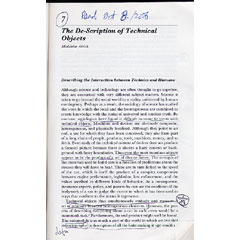
NOTE: This essay is Chapter 7 (pages 205-224) of Bijker & Law (1992) - Shaping Technology / Building Society: Studies in Sociotechnical Change
[205-206] {technology, artifact, society, actor network theory, human, nonhuman} Technical objects thus sumultaneously embody and measure a set of relations between heterogeneous elements... technical objects participate in building heterogeneous networks that bring together actants of all types and sizes, whether human or nonhuman.
[206] {technological determinism, social constructivism, actor network theory} ...we can adopt neither simple technological determinism nor social constructivism. Thus technological determinism pays no attention to what is brought together, and ultimately replaced, by the structural effects of a network. By contrast social constructivism denies the obduracy of objects and assumes that only people can have the status of actors.
[207] {new, technology, artifacts, knowledge, morality, change, people, objects, nature} ...new technologies may not only lead to new arrangements of people and things. They may, in addition, generate and "naturalize" new forms and orders of causality and, indeed, new forms of knowledge about the world... technologies may generate both forms of knowledge and moral judgements.
[208] {inscription, invention, inventor, technology, vision, script, scenario} A large part of the work of innovators is that of "inscribing" this vision of (or prediction about) the world in the technical content of the new object. I will call the end product of this work a "script" or a "scenario."
[208-209] {technology, objects, artifacts, designer, inventor, user, consumer, projected user, real user, worldview, displacement} Thus, if we are interested in technical objects and not in chimerae, we cannot be satisfied methodologically with the designer's or user's point of view alone. Instead we have to go back and forth continually between the designer and the user, between the designer's projected user and the real user, between the world inscribed in the object and the world described by its displacement.
[221] {stabilization, technology, social, economic, political, transfer, data, network, facts, black box} Once technical objects are stabilized, they become instruments of knowledge... If it also chooses categories used in other socioeconomico-political network, then the knowledge it produces can be "exported." "Data" can thus be drawn from the network and transmitted elsewhere... However, the conversion of sociotechnical facts into facts pure and simple depends on the ability to turn technical objects into black boxes. In other words, as they become indispensable, objects also have to efface themselves.
